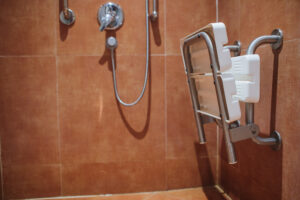Alternatives to Walk-in Tubs

Are you a homeowner in the process of making modifications to help your elderly loved ones age in place? Bathtubs quickly become one of the most dangerous spots in a house as you age, with people over the age of 85 frequently facing injury or hospitalization due to falls that occur while bathing or showering.
Walk-in tubs are often seen as one of the most accessible and helpful home modifications, but they can be difficult to install, expensive and require significantly more space than regular bathtubs. If you have been looking into walk-in tubs for senior safety but don’t think they are the right fit for your home, there are options available. We’ll explore some great alternative solutions to meet seniors’ needs while still maintaining accessibility within their homes.
How Much Do Walk-In Tubs Cost?
An important question to bring clarity to before exploring alternative options is: how much do walk-in tubs cost? Like any new home appliance, the cost of a walk-in tub can vary drastically, but the average cost is $2,500 – $8,000. The total cost can vary depending on labor and the features within the tub as well.
Walk-in tubs are an amazing option for you or a loved one who has mobility issues or is elderly. Knowing your walk-in tub budget can help you determine what the best plan of action for your bathroom modifications are. For more details on cost and different types of walk-in tubs, check out our walk-in tub cost guide.
Walk-In Tub Alternatives
-
Walk-in Shower
Although not much less expensive than a walk-in tub, for those looking for a low barrier entry and more design flexibility, a walk-in shower may be the way to go. With its convenient accessibility features plus ability to both it or stand while bathing, it’s easy to see why this type of bathroom fixture is becoming increasingly popular – especially when used alongside rolling shower chairs as part of wheelchair accessible bathrooms.
-
Grab Bars
Grab bars provide extra stability when taking a bath – giving seniors the peace of mind to stand up and sit down with confidence. Plus, they provide something secure to grab onto when stepping out of the tub.
-
Bathtub/Shower Chairs
For seniors or anyone with mobility issues, shower chairs offer a safe way to bathe without compromising the value of your home. Easy-to- install yet removable, these pieces of equipment guarantee comfort while providing peace of mind that you won’t need to worry about renovation costs if or when it’s time to move.
-
Bathtub Transfer Benches
Transfer benches provide a secure pathway from the bathtub to the floor – ensuring anyone bathing can confidently and safely navigate in and out of the tub. With its bridge-like design, this helpful product offers a solid solution for those who need extra help moving around their bathroom environment.
-
Barrier Free Shower
A barrier free shower is a great alternative to a walk in tub. With its unique open-side, level floor design, the low barrier shower allows for full wheelchair accessibility and eliminates any obstacles that would prevent someone with limited mobility from bathing independently. This is a great option to ensure those with reduced movement can maintain their sense of freedom in an easy way.
-
Bath Chairlift
A bath chairlift will do the trick if you’re looking for a solution that still allows people to be submerged in a bath. Whether you’re seeking convenience or reliability, there are several types of lifts to choose from.
The most common option is battery powered, but you can also find inflatable chair lifts that are inflated in order to reach high enough for someone to sit, then deflate to lower them into the tub.
-
Tub Cut Out
If you’re looking to make your current bathtub more user-friendly, a tub cut out may be the perfect solution. It’s a more affordable way to provide more support for entering and leaving the tub. With this option, a portion of your tub is cut out and replaced with a sealed door.
Smaller Safety Improvements
-
Handheld shower heads
These flexible shower heads can be mounted anywhere and provide much more flexibility in terms of where the water flow can be directed. These are typically within an easy reach as well.
-
Organizer
A designated place for shampoo, soap, etc. makes it easier to find the items needed. This feature can help seniors keep their toiletries and other items within easy reach, without the need to bend or stretch too much.
-
Anti-slip mats
Placing these in particularly slippery spots, such as inside and outside the bathtub, is a minor modification that will make a big difference.
Final Thoughts
Ultimately, aging in place home modifications are essential for safety and ongoing comfort of aging people. Even small changes can make a real difference to the quality of life enjoyed by seniors at home. Home modifications can involve large investments but there are many easier and more reasonable alternatives to walk in tubs.
Minor modifications – including structural reinforcements, grab bars, shower heads, and tub mats – can be very effective for providing support for any senior homeowner wanting to avoid costly renovations or installations. By gaining a better understanding of the options available, homeowners who may not need the extreme specification of a wall in tub can pursue other alternatives. Knowing your options is key!
FAQs
Does Medicare Pay for a Walk-In Tub?
Unfortunately, Medicare does not typically pay for a walk-in tub. The program covers products considered to be “durable medical equipment”, meaning devices that are medically required by a doctor to be used in the home.
Do walk-in tubs decrease home value?
Walk-in tubs can potentially increase a home’s value, but it is influenced by several considerations. Factors like the location of your house, its age and condition, other features in your bathroom, as well as what buyers are looking for will all affect how much additional worth this feature adds to your home.
Additional Walk-In Tub Resources
- Tips for Buying a Walk-In Tub
- Walk-In Tub Accessories
- How to Clean Your Walk-In Tub
- 8 Tips for Saving Money on a Walk-In Tub

Anna has over six years of experience in the home services and journalism industries and serves as the Content Manager at MyHomePros.com, specializing in making complex home improvement topics like HVAC, roofing, and plumbing accessible to all. With a bachelor’s degree in journalism from Auburn University, she excels in crafting localized, comprehensive guides that cater to homeowners’ unique needs. Living on both coasts of the United States has equipped her with a distinctive perspective, fueling her passion for turning any house into a cherished home through informed, personalized decision-making.








